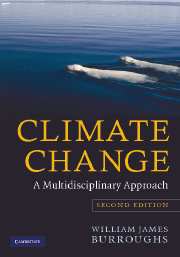Book contents
- Frontmatter
- Contents
- Preface to the second edition
- 1 Introduction
- 2 Radiation and the Earth's energy balance
- 3 The elements of the climate
- 4 The measurement of climate change
- 5 Statistics, significance and cycles
- 6 The natural causes of climate change
- 7 Human activities
- 8 Evidence of climate change
- 9 Consequences of climate change
- 10 Modelling the climate
- 11 Predicting climate change
- Glossary
- Bibliography
- Index
7 - Human activities
Published online by Cambridge University Press: 05 June 2012
- Frontmatter
- Contents
- Preface to the second edition
- 1 Introduction
- 2 Radiation and the Earth's energy balance
- 3 The elements of the climate
- 4 The measurement of climate change
- 5 Statistics, significance and cycles
- 6 The natural causes of climate change
- 7 Human activities
- 8 Evidence of climate change
- 9 Consequences of climate change
- 10 Modelling the climate
- 11 Predicting climate change
- Glossary
- Bibliography
- Index
Summary
I have striven not to laugh at human actions,
not to weep at them, nor to hate them,
but to understand them.
Baruch Spinoza, 1632–1677.How human activities can alter the global climate is best considered separately from natural causes of climatic change. When it comes to predicting how the climate change in the future, in Chapters 10 and 11, we will then need to consider how the combination of natural and human impacts can be analysed together. Now, however, in terms of current perceptions of the causes of climatic change, human activities take priority. Encapsulated in the expression ‘global warming’, it is assumed that these activities are leading to changes are one of the greatest threats to the well-being of humankind in the twenty-first century.
At the local level there is no doubt that human activities alter the climate. As discussed in Section 4.1, correcting for the effects of urbanisation is a major factor in obtaining a reliable measure of temperature trends. Apart from the warming effect of cities, they also reduce wind speeds, reduce visibility by the formation of particulates and photochemical smogs, and, in certain circumstances, increase the chances of heavy precipitation. These effects are, however, restricted to a very small part of the Earth's surface and so far, in terms of global climate change, their consequences are negligible.
- Type
- Chapter
- Information
- Climate ChangeA Multidisciplinary Approach, pp. 200 - 211Publisher: Cambridge University PressPrint publication year: 2007



